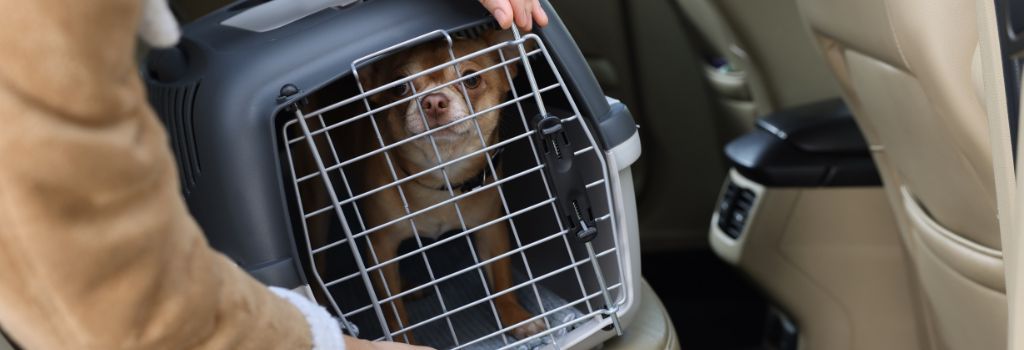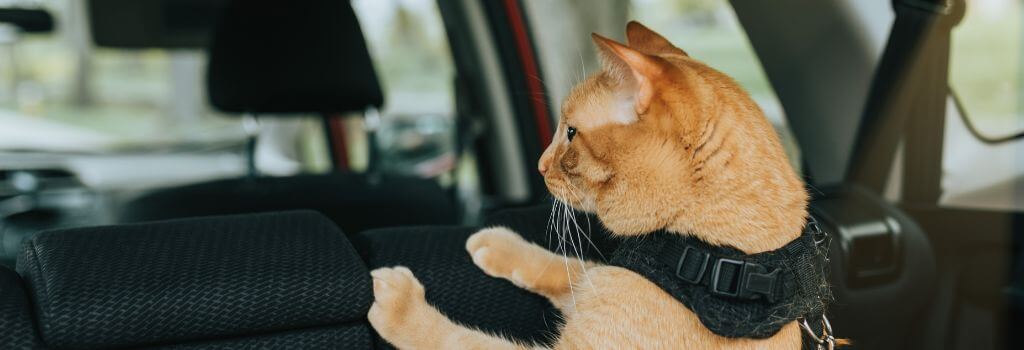It’s no secret that traveling by car can be dangerous. In fact, motor vehicle accidents are one of the top three leading causes of preventable injury-related death in the United States. Ensuring the safety of all passengers, including your furry friends, is crucial when hitting the road. Proper car safety for pets not only protects them from harm but also helps prevent distractions that can lead to accidents.
In this blog, we’ll be breaking down best practices for pet car safety, taking a look at some relevant laws, and giving you our top tips on how to avoid an emergency trip to the vet when taking your dog or cat for a car ride.
Let’s Talk About Location and Restraints
When it comes to bringing your pet on a car ride – no matter the distance – seating location matters. For pet parents who are interested in their dog or cat’s safety while in the car, one of the questions that comes up the most is, “Where is the safest place for my pet to be in the car?” There are a few different answers to this question that will depend on your preferences, as well as the needs of your dog or cat.
When we get in the car, our priority is properly securing ourselves and our children with appropriate seat belts or car seat restraints. But what many pet owners don’t realize is that our pets should be getting the same safety considerations. According to a survey of over 500 American pet owners conducted by Progressive, while pet owners often have good intentions when driving with their pets, 47% of them admitted to letting their pet roam freely in the car. This is a huge safety risk for both pets and their owners.
To help you keep your pet safe and secure for your entire trip, let’s cover a few of the best safety options for your pet and where they should be sitting based on the type of protection you choose to utilize.

Crates and carriers are becoming an increasingly popular choice for pet owners who travel with their dogs or cats often. Securing your dog or cat in a crate or carrier can limit the amount of distractions they present while you’re driving, and can offer additional protection in the event of an accident. Many modern crates are specifically designed for use in the car and are made of strong, impact resistant materials, giving your pet a better chance of walking away from an accident unscathed. Crates and carriers are recommended to be used on the floor of a car, in the backseat, or in the trunk or cargo area, which are the safest locations for your pet to be in the car. Aside from the extra protection and security, crates and carriers can also have a few additional – and unexpected – benefits, like helping to reduce motion sickness in pets by limiting their field of vision.
For pets who get anxious in a confined space like a crate or carrier, or for owners who want to afford their cat or dog a little more freedom, pet seat belts and restraints are a great and affordable option. Restrained pets make travel more comfortable, stress-free, and safe for both the pet and the driver.
Now that we’ve addressed the safest places for your pet to sit in the car, let’s talk about some locations that definitely aren’t safe. The first and most obvious is anywhere in the front of the car, which includes the driver’s seat, passenger seat, either of the wheel wells, and near the dashboard. And yes, this does happen! Pets who are allowed to ride in the front of vehicles can potentially be major distractions, wreak havoc, and even cause accidents. Up in the front seat there’s a greater risk of dogs or cats nudging the steering wheel, gear shift, or even the gas or brake pedal, leading to accidents, and if pets are unrestrained while riding up front, they can potentially be ejected from the car if an accident were to occur.
Familiarize Yourself with Pet Car Safety Laws in Your Area
Animal protection groups, state governments, and law enforcement agencies have seen the need for enhanced pet safety laws and responded with evolving legislation to better protect the health and safety of our pets while they’re traveling with us. Laws will vary by state, so be sure to research your area before bringing your dog or cat along for a ride.
For example, in New Jersey, pet owners need to be aware of the specific laws regarding pet restraints in vehicles. If your pet is not properly restrained while you're driving, it is deemed a direct threat to their safety and wellbeing, and you could face significant fines, even if breaking this law was unintentional. According to the New Jersey Society for the Prevention of Animal Cruelty, a driver can be cited for each unrestrained animal in the vehicle. So, if you have multiple pets loose and unrestrained in your car, the fines can add up quickly. And your wallet may not be the only thing hurting after breaking this law. Violators may face additional penalties, including community service and reimbursement for any costs incurred by agencies involved in investigating the violation. In cases involving juveniles, mandatory mental health counseling may be required.
If you’re traveling through different states, be sure to check local pet transportation laws to ensure you’re in compliance. Just because you’re visiting from out of town or simply passing through for even a few miles, you won’t be excused from following safety laws and regulations.
With so many laws changing and being implemented across the country, it’s better to buckle up and be safe rather than sorry in the event that an accident does occur.
Things You Should Never Do with Your Pet in the Car
Leave Your Pet Unattended
Your pet should never be left in your car unattended. Even if it’s just for a minute or two.
There are a number of emergency situations that could arise from leaving your pet in your car unsupervised. From choking on something they found in your cup holders to rolling down a window and escaping, anything could happen when you leave your pet alone. But perhaps one of the most common, and dangerous, consequences of leaving your pet in the car is heat stroke. While you may think your pet will be fine while you run into the bank, temperatures in cars can rise quickly, especially on a hot day, and lead to life threatening heat stroke. According to the American Veterinary Medical Association, “The temperature inside your vehicle can rise almost 20º F in just 10 minutes, and almost 30º F in 20 minutes. The longer you wait, the higher it goes.” No errand or quick stop will ever be a good reason to leave your pet unattended in the car.
Let Them Ride in the Back of a Pickup Truck or Open Vehicle
While statistics of pet deaths in automobile accidents are not tracked, the American Humane Society estimates that approximately 100,000 animals die each year as a result of riding in the back of open truck beds.
When you let your dog or cat ride in the bed of a truck, you create opportunities for them to jump or fall out of your moving vehicle, and give them little to no protection if you get rear ended. Even if you’re just traveling down the street, your pet should never be exposed and should instead be in the enclosed cab of your vehicle.

Letting Them Get In or Out of the Car Without a Leash or Restraint
Allowing your pet to enter or exit the car without a leash or restraint can be dangerous. Even the most well-trained pets may dash into traffic, potentially causing accidents or getting themself injured. There’s also the possibility that your pet may escape, and run off and get lost, leading to stressful and time-consuming searches that may even end in bad news. Even in a parking lot, sudden movements can startle them, resulting in unpredictable behavior that could harm them or others. It’s a lot easier to secure your pet before getting in or out of the car than it is to chase after them if they get startled and run off!
Engage in Distracted Behavior
For many of us, our pets are our world and often get our undivided attention. But giving your pet attention in the car can result in unsafe, distracted driving.
Whether pet owners realize or not, many of them regularly engage in distracted driving behaviors with their pet in the car. Progressive’s Pet Car Safety survey revealed that 80% of drivers talk to their pets while driving, 41% pet or touch their pets, 23% give treats, and 9% even admitted to taking pictures of their pets while they are behind the wheel. When your focus is on your pet, you’re less aware of the other drivers around you, as well as potential hazards in the road. For the safety of everyone in the car, you should have 100% of your focus on the road; your dog or cat can wait until you reach your destination to get a treat or a couple of head scratches.
If you have questions and you'd like to reach out to us, you can call us directly at (848) 217-5000, or you can email us at [email protected]. Don't forget to follow us on social media Facebook, Instagram.



